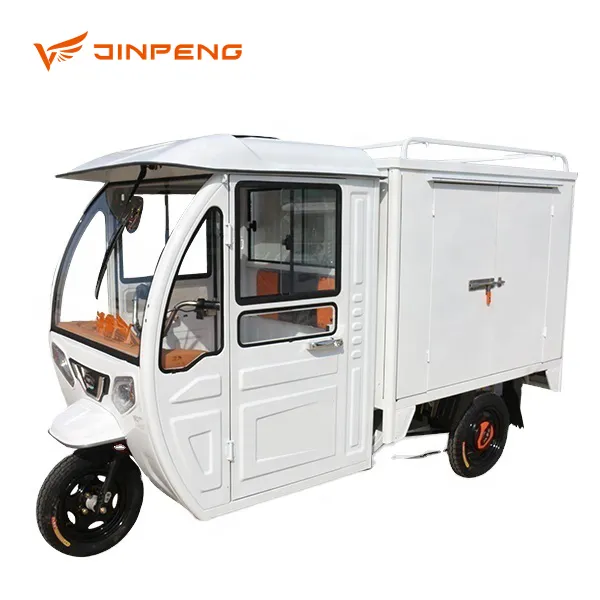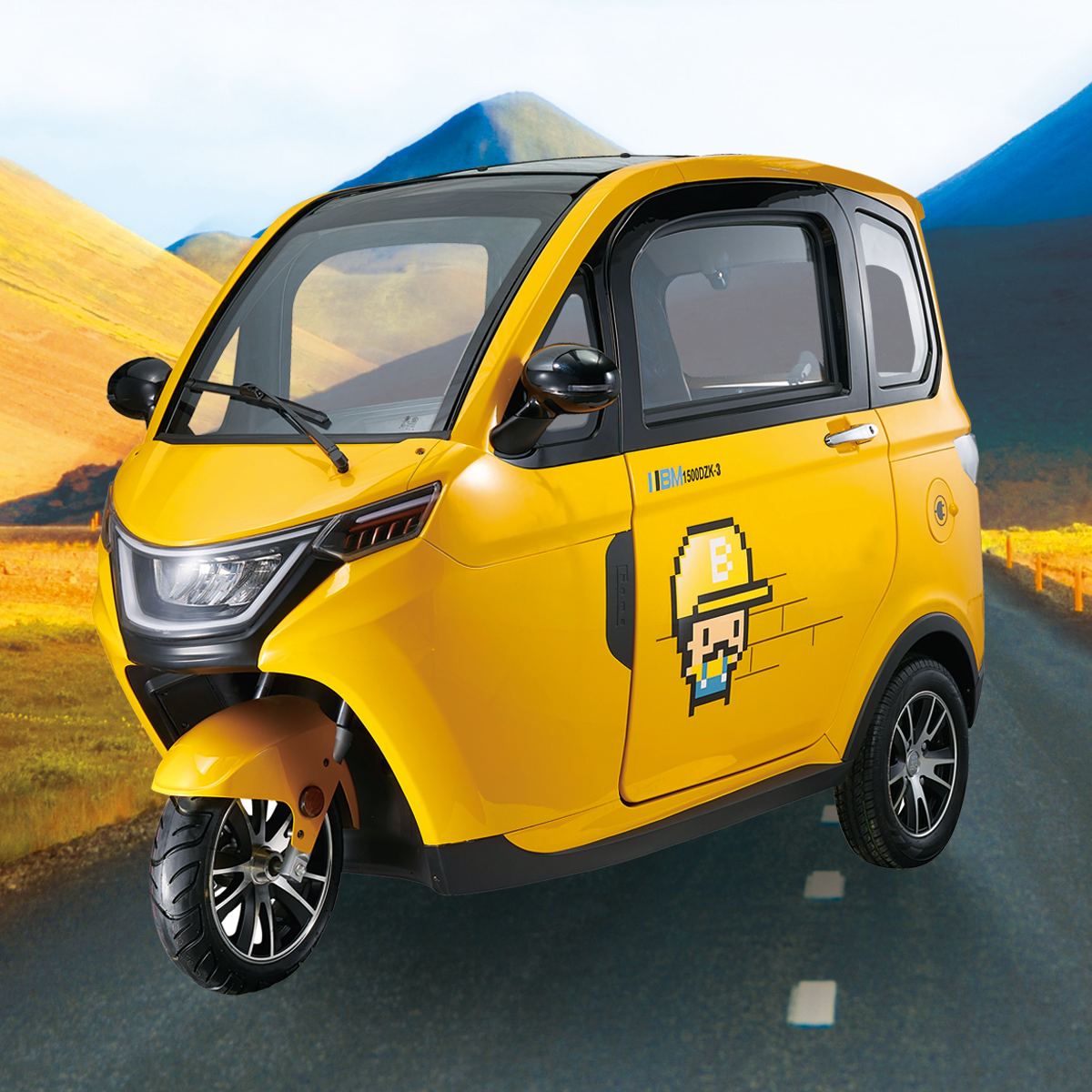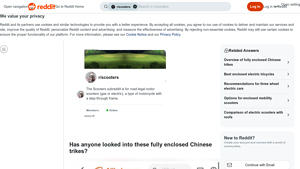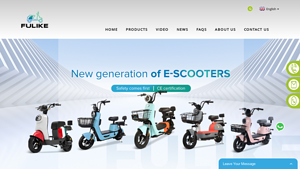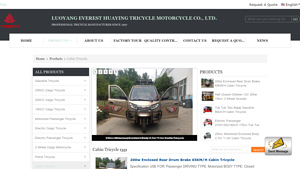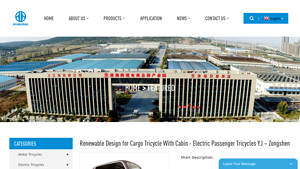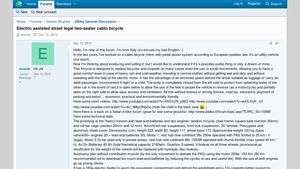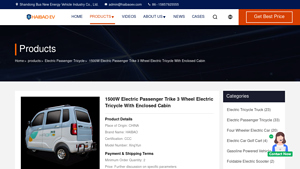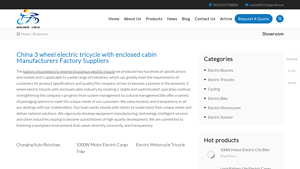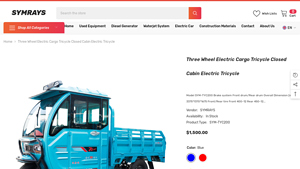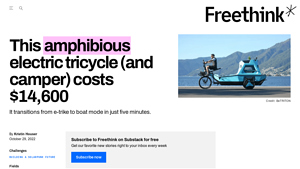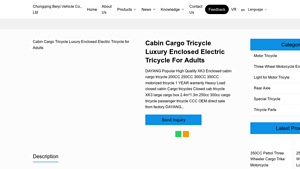Introduction: Navigating the Global Market for cabin electro tricycle
In an era where urban mobility solutions are more critical than ever, sourcing cabin electro tricycles represents a significant challenge for international B2B buyers. As cities across Africa, South America, the Middle East, and Europe grapple with congestion and environmental concerns, these innovative vehicles offer a sustainable and efficient alternative for transportation. This comprehensive guide aims to equip buyers with the knowledge needed to navigate the global market for cabin electro tricycles, covering key aspects such as types, applications, supplier vetting processes, and cost considerations.
Understanding the diverse range of cabin electro tricycles is crucial for making informed purchasing decisions. From models designed for urban commuting to those tailored for delivery services, this guide outlines the various configurations and features available. Additionally, it highlights how to effectively evaluate suppliers, ensuring that quality and compliance with safety standards are prioritized.
By leveraging the insights provided in this guide, B2B buyers can confidently approach their sourcing strategies, aligning their choices with the needs of their target markets. Whether you’re operating in Brazil’s bustling cities or navigating the transport landscapes of Nigeria, this resource is designed to empower your purchasing decisions, ultimately fostering sustainable and profitable business ventures.
Understanding cabin electro tricycle Types and Variations
| Type Name | Key Distinguishing Features | Primary B2B Applications | Brief Pros & Cons for Buyers |
|---|---|---|---|
| Enclosed Passenger Tricycle | Spacious cabin, ergonomic seating, weather protection | Urban commuting, taxi services | Pros: Comfortable, safe, low emissions. Cons: Higher initial cost. |
| Cargo Delivery Tricycle | Larger cargo space, reinforced structure, customizable payload | Logistics, delivery services | Pros: High load capacity, durable. Cons: Limited passenger space. |
| Elderly Mobility Tricycle | Low step-in height, easy controls, stability features | Senior transport, healthcare services | Pros: Accessible, user-friendly. Cons: Slower speed options. |
| Half Enclosed Tricycle | Partial cabin, lightweight design, improved aerodynamics | Short-distance commuting, recreational use | Pros: Affordable, versatile. Cons: Less protection from elements. |
| Solar-Powered Tricycle | Integrated solar panels, eco-friendly, energy-efficient | Sustainable transport solutions | Pros: Reduced operating costs, low environmental impact. Cons: Higher upfront investment. |
What Are the Key Characteristics of Enclosed Passenger Tricycles?
Enclosed passenger tricycles are designed for urban commuting, offering a spacious cabin that protects riders from adverse weather conditions. Equipped with ergonomic seating and advanced safety features, these vehicles prioritize passenger comfort and safety. B2B buyers should consider their application in taxi services or urban transportation, as they provide a reliable solution for short-distance travel while maintaining low carbon emissions.
How Do Cargo Delivery Tricycles Meet Logistics Needs?
Cargo delivery tricycles are distinguished by their larger cargo space and reinforced structures, making them suitable for logistics and delivery services. These vehicles can be customized to accommodate varying payloads, enhancing their utility for businesses involved in transportation and delivery. Buyers should evaluate the durability and load capacity of these tricycles to ensure they meet their operational demands effectively.
What Makes Elderly Mobility Tricycles Ideal for Healthcare?
Elderly mobility tricycles are specifically designed for senior users, featuring low step-in heights and easy-to-use controls. These vehicles enhance mobility for elderly individuals, making them suitable for healthcare services and senior transport. When considering this option, B2B buyers should focus on the stability features and user-friendliness that cater to the needs of older passengers, ensuring safe and comfortable travel.
Why Choose Half Enclosed Tricycles for Recreational Use?
Half enclosed tricycles offer a lightweight design and improved aerodynamics, making them ideal for short-distance commuting and recreational activities. Their affordability and versatility appeal to a broad range of users, from casual riders to those needing quick transportation solutions. Buyers should weigh the trade-offs of reduced protection from the elements against the lower cost and flexibility these models provide.
What Are the Benefits of Solar-Powered Tricycles in Sustainable Transport?
Solar-powered tricycles integrate solar panels to enhance energy efficiency, making them an excellent choice for businesses focused on sustainability. These vehicles can significantly reduce operating costs and environmental impact. B2B buyers should consider the higher initial investment against long-term savings and the positive branding associated with eco-friendly transport solutions.
Key Industrial Applications of cabin electro tricycle
| Industry/Sector | Specific Application of cabin electro tricycle | Value/Benefit for the Business | Key Sourcing Considerations for this Application |
|---|---|---|---|
| Urban Transportation | Last-mile delivery for urban areas | Reduces congestion and emissions while providing efficient transport | Consider battery range, motor power, and vehicle size for urban routes |
| Tourism and Leisure | Sightseeing and guided tours in urban and rural areas | Offers a unique, eco-friendly transportation option for tourists | Look for customizable branding options and ergonomic designs |
| Healthcare and Elderly Care | Patient transport within healthcare facilities | Ensures safe, comfortable transport for patients and elderly | Focus on safety features, ease of access, and comfort specifications |
| Retail and E-commerce | Delivery of goods in densely populated areas | Enhances delivery speed and reduces operational costs | Evaluate cargo capacity and battery efficiency for delivery needs |
| Agriculture | Transport of produce and supplies within farms | Provides efficient movement of goods across agricultural sites | Assess terrain capabilities and durability for rugged environments |
How are cabin electro tricycles utilized in urban transportation for last-mile delivery?
In urban areas, cabin electro tricycles are increasingly used for last-mile delivery solutions. These vehicles can navigate congested streets and provide a greener alternative to traditional delivery vans, thus reducing traffic and emissions. With their enclosed cabins, they protect goods from adverse weather, ensuring that deliveries remain intact. For international buyers, especially in regions like Africa and South America, sourcing options should prioritize battery range and motor power to meet the demands of urban logistics.
What role do cabin electro tricycles play in tourism and leisure activities?
Cabin electro tricycles serve as an innovative transport option for tourists, providing guided tours in both urban and rural settings. Their eco-friendly design aligns with the growing demand for sustainable travel experiences. These tricycles can be customized with branding for tour operators, enhancing marketing efforts. Buyers in Europe and the Middle East should focus on ergonomic designs and comfort features to cater to diverse tourist demographics, ensuring a pleasant experience.
How are cabin electro tricycles beneficial in healthcare and elderly care sectors?
In healthcare facilities, cabin electro tricycles are utilized for transporting patients safely and comfortably. Their enclosed design offers protection and ease of access, making them suitable for elderly individuals or those with mobility challenges. The low operational costs and minimal maintenance requirements are attractive to healthcare providers. Buyers must prioritize safety features and comfort specifications when sourcing these vehicles to meet the specific needs of patients.
In what ways do cabin electro tricycles enhance retail and e-commerce delivery?
Cabin electro tricycles are increasingly adopted by retail and e-commerce businesses for efficient goods delivery in densely populated areas. Their compact size allows for easy maneuverability, while their enclosed design ensures the protection of products during transit. This results in faster delivery times and reduced operational costs. Buyers should evaluate cargo capacity and battery efficiency when sourcing these vehicles to align with their delivery requirements.
How can cabin electro tricycles improve agricultural transport?
In the agricultural sector, cabin electro tricycles facilitate the transportation of produce and supplies across farms. Their ability to navigate uneven terrain and carry substantial loads makes them invaluable for efficient operations. These vehicles can enhance productivity by reducing the time taken to move goods. Buyers should assess durability and terrain capabilities when sourcing tricycles for agricultural applications, ensuring they can withstand rugged environments.
3 Common User Pain Points for ‘cabin electro tricycle’ & Their Solutions
Scenario 1: Navigating Limited Range Concerns for Urban Use
The Problem: B2B buyers, especially those involved in transportation services or urban delivery, often face the challenge of limited range on electric vehicles. Many cabin electro tricycles have a maximum range of 30 to 90 kilometers on a single charge, which can be inadequate for businesses that require longer operational hours and extensive travel. This limitation can lead to concerns about vehicle downtime, increased operational costs, and potential customer dissatisfaction due to delayed deliveries.
The Solution: To effectively address range concerns, B2B buyers should consider sourcing cabin electro tricycles with customizable battery options. Opting for models with higher capacity lithium batteries (such as 60AH) can significantly extend travel distances. Buyers should also evaluate the specific motor power and performance capabilities of the tricycles, ensuring they align with their operational needs. Additionally, integrating charging stations in strategic locations can mitigate downtime. Encouraging drivers to utilize energy-efficient driving techniques, such as maintaining steady speeds and minimizing rapid acceleration, can further enhance the effective range of the vehicles.
Scenario 2: Ensuring Safety and Compliance in Diverse Markets
The Problem: As B2B buyers from different regions, such as Africa or South America, seek to introduce cabin electro tricycles into their fleets, they often encounter varying safety regulations and compliance standards. Inconsistent safety features across models can raise concerns about passenger safety, leading to potential liability issues and regulatory challenges. Buyers may feel overwhelmed by the need to ensure that the vehicles meet local standards while still being functional and attractive to customers.
The Solution: To navigate these complexities, buyers should prioritize sourcing tricycles from manufacturers that offer comprehensive safety features and comply with international standards. It is essential to conduct thorough research on local regulations and engage with manufacturers who can provide documentation demonstrating compliance with safety standards. Implementing additional safety features, such as anti-skid tires, safety belts, and robust lighting systems, can enhance passenger safety. Buyers should also consider conducting in-house training for drivers on best practices for safety and emergency procedures, thereby fostering a culture of safety within their operations.
Scenario 3: Customization for Diverse Business Needs
The Problem: Many B2B buyers require cabin electro tricycles that can be adapted to various business functions, whether for passenger transport, deliveries, or services for the elderly. However, standard models may not offer the necessary customization options, leading to inefficiencies or a mismatch between vehicle capabilities and business requirements. Buyers may find themselves limited in their operational flexibility and unable to fully meet customer demands.
The Solution: To overcome this challenge, buyers should actively seek manufacturers that provide extensive customization options. This includes variations in seating configurations, motor specifications, and additional features like luggage racks or climate control systems. Engaging with manufacturers early in the sourcing process allows buyers to specify their unique needs, ensuring that the tricycles can be tailored for specific applications. Additionally, buyers should consider modular designs that allow for future upgrades or changes in specifications, thus maximizing the long-term utility of their investment. Collaboration with manufacturers to co-develop unique solutions can also lead to a competitive advantage in their respective markets.
Strategic Material Selection Guide for cabin electro tricycle
When selecting materials for cabin electro tricycles, manufacturers must consider a variety of factors, including performance, durability, cost, and compliance with international standards. Below, we analyze four common materials used in the construction of cabin electro tricycles, focusing on their properties, advantages, disadvantages, and implications for international buyers.
What Are the Key Properties of Plastic in Cabin Electro Tricycles?
Plastic, particularly high-density polyethylene (HDPE) or polycarbonate, is frequently used for the body of cabin electro tricycles due to its lightweight nature and versatility. These materials typically exhibit excellent impact resistance, making them suitable for urban environments where durability is essential. They also offer good thermal insulation, which can enhance passenger comfort.
Pros: Plastics are generally cost-effective and easy to mold into complex shapes, allowing for innovative designs. They are resistant to corrosion and do not require extensive maintenance.
Cons: However, plastics can be less durable than metals in extreme conditions, such as high temperatures or heavy impacts. They may also degrade over time when exposed to UV light unless treated.
Impact on Application: The use of plastic can significantly reduce the overall weight of the tricycle, improving energy efficiency and range. However, manufacturers should ensure that the selected plastic is suitable for the specific climate conditions of the target market.
How Does Metal Compare for Cabin Electro Tricycles?
Metal, particularly steel or aluminum, is another common material choice for cabin electro tricycles. Steel offers high strength and durability, making it suitable for structural components. Aluminum, while more expensive, provides a lightweight alternative with excellent corrosion resistance.
Pros: Metals are robust and can withstand harsh environmental conditions, making them ideal for regions with extreme weather. They also provide a higher level of safety due to their structural integrity.
Cons: The primary downside is the higher cost and complexity in manufacturing processes, such as welding and forming. Additionally, metals can be heavier, which may impact energy efficiency.
Impact on Application: The choice of metal can influence the overall safety and longevity of the vehicle. Buyers in regions with strict safety regulations may prefer metal for its proven performance.
What Role Does Composite Material Play in Cabin Electro Tricycles?
Composite materials, often a combination of fibers and resins, are becoming increasingly popular in the automotive industry, including for cabin electro tricycles. These materials are engineered to provide high strength-to-weight ratios, making them an attractive option.
Pros: Composites are lightweight and can be molded into complex shapes, providing design flexibility. They also exhibit excellent resistance to corrosion and fatigue.
Cons: The manufacturing process can be more complex and costly compared to traditional materials. Additionally, repair and recycling of composites can pose challenges.
Impact on Application: Composites can enhance the performance of the tricycle by reducing weight and improving fuel efficiency. However, international buyers should consider the availability of repair services and recycling options in their regions.
How Important Are Rubber and Foam Materials in Cabin Electro Tricycles?
Rubber and foam materials are essential for various components, including tires, seals, and interior cushioning. Rubber provides excellent traction and durability, while foam materials enhance passenger comfort and insulation.
Pros: Rubber is highly resistant to wear and provides good grip, making it ideal for tires. Foam materials are lightweight and can absorb shocks effectively.
Cons: The main drawback of rubber is its susceptibility to degradation from UV exposure and extreme temperatures. Foam can also compress over time, reducing its effectiveness.
Impact on Application: The choice of rubber and foam materials can significantly influence ride quality and safety. Buyers should ensure that these materials meet local standards for durability and performance.
Summary Table of Material Selection for Cabin Electro Tricycles
| Material | Typical Use Case for cabin electro tricycle | Key Advantage | Key Disadvantage/Limitation | Relative Cost (Low/Med/High) |
|---|---|---|---|---|
| Plastic | Body panels and interior components | Lightweight, cost-effective | Less durable in extreme conditions | Low |
| Metal (Steel/Aluminum) | Structural components | High strength and safety | Higher cost and manufacturing complexity | Med |
| Composite | Body and structural elements | High strength-to-weight ratio | Complex manufacturing and repair challenges | High |
| Rubber/Foam | Tires and interior cushioning | Excellent traction and shock absorption | Susceptible to UV degradation | Low |
In conclusion, the selection of materials for cabin electro tricycles is critical for performance, safety, and compliance with international standards. Buyers from regions like Africa, South America, the Middle East, and Europe should carefully evaluate these factors to ensure they choose the most suitable materials for their specific needs and market conditions.
In-depth Look: Manufacturing Processes and Quality Assurance for cabin electro tricycle
What Are the Main Stages in the Manufacturing Process of Cabin Electro Tricycles?
The manufacturing process of cabin electro tricycles is a multi-stage operation that ensures the production of high-quality vehicles suited for various markets. The main stages include material preparation, forming, assembly, and finishing.
-
Material Preparation: The first step involves sourcing high-quality raw materials such as metals, plastics, and electrical components. Manufacturers typically utilize advanced materials that offer durability and lightweight properties. The selection of materials is crucial as it affects the tricycle’s overall performance, safety, and longevity.
-
Forming: This stage involves shaping the prepared materials into the desired components of the tricycle. Techniques like stamping, molding, and CNC machining are commonly employed. For instance, the body of the tricycle may be created using plastic injection molding, which allows for complex shapes and designs while maintaining strength and reducing weight.
-
Assembly: Once the components are formed, they are brought together in a systematic assembly line. This process can involve manual labor and automated machinery, ensuring precision and efficiency. Key parts such as the electric motor, battery, cabin structure, and wheels are assembled meticulously to ensure they fit together seamlessly.
-
Finishing: After assembly, the tricycles undergo finishing processes, which may include painting, surface treatment, and quality checks. This stage enhances the aesthetic appeal and protects against environmental factors, ensuring that the vehicles are ready for market deployment.
How Is Quality Assurance Implemented in Cabin Electro Tricycle Manufacturing?
Quality assurance (QA) is integral to the manufacturing of cabin electro tricycles, ensuring that each vehicle meets international standards and customer expectations. Manufacturers typically adhere to recognized standards such as ISO 9001, which provides a framework for consistent quality management.
-
International Standards and Certifications: Compliance with ISO 9001 indicates a commitment to quality management systems. Additionally, certifications like CE and API are crucial for markets in Europe and other regions, ensuring that products meet specific safety and performance criteria. These certifications not only enhance product credibility but also facilitate smoother market entry.
-
Quality Control Checkpoints:
– Incoming Quality Control (IQC): This initial checkpoint focuses on assessing the quality of raw materials before they enter the production line. Suppliers must provide documentation that verifies compliance with quality standards.
– In-Process Quality Control (IPQC): During the assembly phase, regular inspections are conducted to identify and rectify defects early in the process. This includes monitoring assembly techniques and ensuring that components fit as intended.
– Final Quality Control (FQC): Before the tricycles are dispatched, a comprehensive final inspection is conducted. This may involve functional testing of electrical components, safety features, and overall performance metrics. -
Common Testing Methods: Various testing methods are employed to ensure the quality of the tricycles. These may include:
– Durability Testing: Assessing the vehicle’s ability to withstand environmental stresses, including temperature extremes and moisture.
– Safety Testing: Evaluating safety features like seat belts, braking systems, and stability under load.
– Performance Testing: Measuring speed, battery efficiency, and climbing ability under various conditions.
What Steps Can B2B Buyers Take to Verify Supplier Quality Control?
For B2B buyers, especially those from diverse regions such as Africa, South America, the Middle East, and Europe, verifying supplier quality control is crucial in ensuring the reliability of their purchases.
-
Conducting Supplier Audits: Potential buyers should conduct thorough audits of the manufacturing facilities. This includes reviewing production processes, quality management systems, and compliance with international standards. Engaging third-party auditing firms can provide unbiased assessments.
-
Requesting Quality Reports: Suppliers should provide detailed quality control reports, including documentation of inspections and testing results. This transparency allows buyers to assess the quality assurance measures in place.
-
Utilizing Third-Party Inspection Services: Hiring third-party inspection agencies can further validate the quality of the products before shipment. These agencies can conduct inspections at various stages of production and ensure that the final products adhere to agreed-upon specifications.
What Quality Control and Certification Nuances Should International B2B Buyers Be Aware Of?
Understanding the nuances of quality control and certification can be particularly beneficial for international buyers. Each region may have specific requirements and expectations, influencing the selection process for cabin electro tricycles.
-
Regional Compliance Standards: Buyers should familiarize themselves with the compliance standards relevant to their region. For instance, European buyers may prioritize CE certification, while buyers in Africa may focus on local safety and performance standards. Each market may have distinct regulations that impact vehicle design and functionality.
-
Language and Documentation Barriers: Communication can often pose challenges. Buyers should ensure that all documentation, including quality reports and compliance certificates, is available in a language they understand. This helps avoid misunderstandings regarding product specifications and quality expectations.
-
Cultural Considerations in Quality Expectations: Different regions may have varying perceptions of quality. Buyers should engage in discussions with suppliers to align expectations on quality standards, performance metrics, and after-sales service. Building a strong relationship with suppliers can facilitate smoother transactions and better quality assurance.
Conclusion
The manufacturing processes and quality assurance measures for cabin electro tricycles are designed to ensure that these vehicles meet the diverse needs of international markets. By understanding the manufacturing stages, quality control checkpoints, and verification methods, B2B buyers can make informed decisions when sourcing these innovative vehicles. Engaging with suppliers who prioritize quality and compliance will ultimately lead to a more successful procurement experience.
Practical Sourcing Guide: A Step-by-Step Checklist for ‘cabin electro tricycle’
This guide serves as a practical checklist for B2B buyers seeking to procure cabin electro tricycles, ensuring a streamlined and informed purchasing process. By following these steps, buyers can make educated decisions that align with their operational needs and market demands.
Step 1: Define Your Technical Specifications
Before engaging suppliers, clearly outline the technical specifications required for your cabin electro tricycle. Consider aspects such as passenger capacity, motor power (ranging from 800W to 1500W), battery type (lead-acid vs. lithium), and maximum speed (typically between 25 to 35 km/h). Defining these parameters will help you communicate effectively with suppliers and ensure that the vehicles meet your operational requirements.
Step 2: Research Regulatory Compliance Requirements
Understanding local regulations is crucial when sourcing electric tricycles. Different regions may have specific laws regarding vehicle safety, emissions, and licensing. For example, some countries classify enclosed electric tricycles as low-speed vehicles, which may not require a license. Familiarize yourself with these regulations to avoid potential legal issues and ensure that the vehicles you purchase are compliant.
Step 3: Evaluate Potential Suppliers
Thoroughly vet suppliers to ensure they can meet your requirements. Look for established manufacturers with a strong reputation in the industry, especially those with experience in your target markets such as Africa, South America, and Europe. Request documentation such as ISO certifications, product quality assurance reports, and references from other buyers in similar sectors to gauge reliability and product quality.
Step 4: Assess Product Quality and Features
Examine the quality and features of the cabin electro tricycles. Key aspects to evaluate include the robustness of the frame, comfort of the cabin, safety features (like anti-skid tires and safety belts), and energy efficiency. Request samples or detailed product specifications to ensure that the tricycles can withstand the intended use in various environments, particularly in areas with challenging road conditions.
Step 5: Inquire About Customization Options
Customization can significantly enhance the functionality of your electro tricycle. Inquire about available options such as motor specifications, seating configurations, and additional features like reversing cameras and anti-theft systems. Customization can also extend to branding opportunities, allowing you to incorporate your company’s logo and color scheme.
Step 6: Evaluate Pricing and Payment Terms
Once you have shortlisted potential suppliers, compare pricing structures to identify the best value. Consider not just the upfront cost but also the long-term value, including maintenance costs and battery lifespan. Discuss payment terms, including any available financing options or bulk purchase discounts, to ensure that the procurement aligns with your budgetary constraints.
Step 7: Plan for After-Sales Support and Maintenance
After selecting a supplier, ensure that they provide comprehensive after-sales support. This includes warranty terms, availability of spare parts, and guidance on maintenance practices. Regular maintenance is essential for the longevity of cabin electro tricycles, so confirming the supplier’s commitment to support can be a deciding factor in your purchasing decision.
By following this checklist, B2B buyers can navigate the procurement process for cabin electro tricycles effectively, ensuring that their investments align with operational goals and market needs.
Comprehensive Cost and Pricing Analysis for cabin electro tricycle Sourcing
What Are the Key Cost Components in Cabin Electro Tricycle Manufacturing?
Understanding the cost structure of cabin electro tricycles is essential for B2B buyers looking to make informed sourcing decisions. The primary cost components include materials, labor, manufacturing overhead, tooling, quality control (QC), logistics, and profit margins.
-
Materials: The choice of materials significantly impacts costs. Plastic shells tend to be more economical compared to metal shells, but the latter offers enhanced durability and safety. Battery types also play a crucial role; while lead-acid batteries are cheaper upfront, lithium batteries provide longer life and efficiency, affecting long-term costs.
-
Labor: Labor costs vary by region. Countries with lower wage rates may offer competitive pricing but could compromise on quality. Understanding the local labor market of the manufacturing country is vital for assessing overall cost.
-
Manufacturing Overhead: This includes utilities, facility costs, and indirect labor. Efficient production processes can reduce overhead and thus lower the final price of the tricycles.
-
Tooling: Initial investments in tooling for specialized parts can be significant. Buyers should inquire about the tooling costs, especially if customization is required, as these can affect the overall pricing structure.
-
Quality Control: Implementing stringent QC processes can increase costs but ensures product reliability. Buyers should consider the balance between cost and quality when evaluating potential suppliers.
-
Logistics: Shipping costs are influenced by distance, mode of transport, and Incoterms. Buyers must factor in these logistics costs when calculating the total price.
-
Margin: Suppliers typically include a profit margin that varies depending on their market position and competitiveness. Understanding the margin structure can provide insight into pricing flexibility during negotiations.
How Do Price Influencers Affect Cabin Electro Tricycle Sourcing?
Several factors influence the pricing of cabin electro tricycles, which buyers must consider when sourcing:
-
Volume/MOQ: Purchasing in larger quantities often leads to reduced prices per unit. Establishing minimum order quantities (MOQs) can help negotiate better rates.
-
Specifications and Customization: Custom features, such as unique designs or enhanced safety options, can lead to higher costs. Buyers should clearly define their specifications to avoid unexpected charges.
-
Materials and Quality Certifications: Premium materials and certified products (e.g., safety certifications) command higher prices. Buyers should assess whether these certifications are necessary for their market to avoid overpaying.
-
Supplier Factors: Supplier reputation, reliability, and production capacity can influence pricing. Established suppliers may charge more due to their proven track record, but they often offer better quality and support.
-
Incoterms: Understanding shipping terms (like FOB, CIF, etc.) is crucial as they dictate who bears the cost and risk at various stages of transportation. This knowledge can help buyers negotiate better terms and control costs.
What Are the Best Buyer Tips for Negotiating Cabin Electro Tricycle Prices?
To secure the best deals on cabin electro tricycles, international B2B buyers should consider the following tips:
-
Negotiate Wisely: Leverage volume purchases and long-term relationships to negotiate lower prices. Be transparent about your budget and requirements to foster collaboration.
-
Focus on Cost-Efficiency: Evaluate the Total Cost of Ownership (TCO), which includes not just the purchase price but also maintenance, operational costs, and potential resale value. This perspective can help identify the most cost-effective options.
-
Understand Pricing Nuances for International Sourcing: Different regions may have varying pricing structures due to local labor and material costs. Buyers from Africa, South America, the Middle East, and Europe should conduct thorough market research to understand these dynamics.
-
Be Aware of Indicative Prices: Always request detailed quotations and avoid relying solely on indicative prices, which can fluctuate based on market conditions. Ensure that all aspects of the cost are accounted for in any agreement.
By understanding these cost components, price influencers, and negotiation strategies, B2B buyers can make well-informed decisions when sourcing cabin electro tricycles, leading to better financial outcomes and enhanced operational efficiency.
Alternatives Analysis: Comparing cabin electro tricycle With Other Solutions
Exploring Alternative Solutions to Cabin Electro Tricycles
In the evolving landscape of urban mobility, businesses are increasingly seeking efficient transportation solutions. While cabin electro tricycles offer a unique blend of comfort, safety, and eco-friendliness, it is essential to evaluate alternative options that might better suit specific operational needs. This analysis compares cabin electro tricycles with two viable alternatives: electric scooters and traditional gas-powered tuk-tuks.
Comparison Table
| Comparison Aspect | Cabin Electro Tricycle | Electric Scooter | Gas-Powered Tuk-Tuk |
|---|---|---|---|
| Performance | Speed: 25-35 km/h; Range: 30-90 km | Speed: 25-50 km/h; Range: 25-60 km | Speed: 30-50 km/h; Range: 100-200 km |
| Cost | Moderate initial investment; low operating costs | Low initial cost; moderate operating costs | Lower initial cost; higher fuel costs |
| Ease of Implementation | Requires some infrastructure; street legal in many areas | Minimal infrastructure needed; easy to deploy | Requires roads suitable for heavier vehicles |
| Maintenance | Low maintenance; routine care needed | Very low maintenance; battery checks | Moderate maintenance; engine upkeep needed |
| Best Use Case | Ideal for urban commuting and short deliveries | Best for individual users and short trips | Suitable for longer distances and tourist transport |
Detailed Breakdown of Alternatives
Electric Scooter
Electric scooters have gained popularity as a flexible transportation option, especially for individual users. They are lightweight, easy to maneuver, and can be deployed quickly without significant infrastructure requirements. However, their limited range and speed may not be sufficient for businesses needing reliable transport for multiple passengers or goods. Additionally, while electric scooters have lower maintenance needs, their batteries may require more frequent replacements, impacting long-term costs.
Gas-Powered Tuk-Tuk
Gas-powered tuk-tuks are a traditional choice in many developing markets, known for their ability to carry multiple passengers and navigate narrow streets. They offer a longer range than electric alternatives, making them suitable for longer trips or areas with limited charging infrastructure. However, the reliance on fossil fuels leads to higher operational costs over time and raises environmental concerns. Maintenance can also be more demanding due to the mechanical components involved, making it less appealing for eco-conscious businesses.
Conclusion: Choosing the Right Solution for Your Business Needs
When selecting the ideal transportation solution, B2B buyers should consider their specific operational requirements, including range, capacity, and environmental impact. Cabin electro tricycles stand out for urban commuting with their enclosed cabins and safety features, making them ideal for passenger transport in adverse weather. Electric scooters are excellent for individual mobility with minimal investment, while gas-powered tuk-tuks may serve businesses needing to cover longer distances with a larger passenger capacity. Ultimately, the decision should align with the strategic goals of the business, taking into account factors such as sustainability, cost efficiency, and service reliability.
Essential Technical Properties and Trade Terminology for cabin electro tricycle
What Are the Key Technical Properties of a Cabin Electro Tricycle?
When considering a cabin electro tricycle for commercial use, understanding its technical properties is essential for making informed purchasing decisions. Here are some critical specifications that B2B buyers should evaluate:
1. Material Grade
The body of a cabin electro tricycle is typically constructed from either high-strength steel or durable plastic composites. High-strength steel offers enhanced safety and longevity, making it suitable for heavy-duty applications. Plastic composites, on the other hand, provide a lightweight solution that can improve energy efficiency. Understanding the material grade helps buyers assess durability and maintenance costs.
2. Motor Power
Motor power is a crucial specification that directly impacts the tricycle’s performance. Common options range from 800W to 1500W. A higher wattage provides better acceleration and climbing ability, which is particularly important in hilly terrains. B2B buyers should consider the intended use of the tricycle—whether for urban commuting or delivery services—to select the appropriate motor power.
3. Battery Capacity and Type
Battery capacity is measured in amp-hours (Ah) and influences the range of the tricycle. Options typically include lead-acid (32AH, 45AH, 52AH, and 60AH) and lithium batteries. Lithium batteries, while more expensive, offer longer lifespans and better performance, making them a worthwhile investment for frequent users. Understanding battery specifications helps buyers evaluate the operational costs and range of the tricycle.
4. Maximum Speed
The maximum speed of cabin electro tricycles generally falls between 25 to 35 km/h (approximately 15.5 to 21.7 mph). Speed requirements may vary based on local regulations and specific operational needs. Buyers should be aware of these factors to ensure compliance with safety standards while meeting their transportation demands.
5. Climbing Ability
The climbing capability, typically rated between 15° to 30°, is essential for assessing the tricycle’s performance on inclines. This specification is particularly relevant in regions with varied topography, affecting the vehicle’s efficiency and usability. Buyers should consider the geographical conditions of their target market when evaluating climbing ability.
What Are Common Trade Terms in the Cabin Electro Tricycle Industry?
Understanding trade terminology is vital for smooth transactions in the B2B environment. Here are several common terms that buyers should familiarize themselves with:
1. OEM (Original Equipment Manufacturer)
OEM refers to companies that manufacture products that are sold under another company’s brand. In the context of cabin electro tricycles, it indicates that a manufacturer can produce vehicles according to a buyer’s specifications, allowing for customization in branding and design.
2. MOQ (Minimum Order Quantity)
MOQ is the smallest quantity of a product that a supplier is willing to sell. This term is crucial for B2B buyers, as it affects inventory management and cash flow. Understanding MOQ helps businesses plan their purchases and negotiate better terms with suppliers.
3. RFQ (Request for Quotation)
An RFQ is a document sent to suppliers to request pricing and terms for specific products. For buyers, issuing an RFQ is an effective way to compare offers from multiple suppliers, ensuring they receive the best possible deal.
4. Incoterms (International Commercial Terms)
Incoterms are internationally recognized rules that define the responsibilities of buyers and sellers in international transactions. Understanding these terms helps B2B buyers clarify shipping costs, risks, and delivery responsibilities, which is essential for smooth logistics.
5. Lead Time
Lead time refers to the amount of time it takes from placing an order to receiving the product. In the cabin electro tricycle market, lead times can vary significantly based on customization and manufacturing capabilities. Buyers should factor lead time into their planning to avoid disruptions in their supply chain.
By understanding both the technical specifications and the relevant trade terminology, B2B buyers can make more informed decisions when sourcing cabin electro tricycles, ensuring they meet their operational needs and market demands.
Navigating Market Dynamics and Sourcing Trends in the cabin electro tricycle Sector
What Are the Current Market Dynamics and Key Trends for Cabin Electro Tricycles?
The global market for cabin electro tricycles is on the rise, driven by increasing urbanization and the need for sustainable transportation solutions. As cities grapple with congestion and pollution, these compact, enclosed vehicles offer an attractive alternative for short-distance travel. In regions like Africa and South America, where infrastructure may be less developed, cabin electro tricycles provide a versatile solution for both personal and commercial use, catering to urban commuters and delivery services alike. Moreover, the growing emphasis on eco-friendly technologies is propelling demand, with many buyers prioritizing electric vehicles that reduce carbon footprints.
Emerging trends in B2B sourcing for cabin electro tricycles include the integration of advanced technologies such as IoT for fleet management, and the use of AI for route optimization. International buyers, particularly from Europe and the Middle East, are increasingly seeking suppliers that offer customization options, including varied battery capacities and motor specifications to meet specific market needs. Furthermore, as competition intensifies, manufacturers are focusing on enhancing safety features and ergonomic designs, which are crucial for attracting discerning buyers.
How Can Sustainability and Ethical Sourcing Impact Your Cabin Electro Tricycle Purchasing Decisions?
Sustainability plays a pivotal role in the sourcing of cabin electro tricycles. Buyers are increasingly aware of the environmental impact associated with production and supply chains. Opting for manufacturers that utilize sustainable materials and practices can significantly enhance a company’s brand image while contributing to global efforts to combat climate change. For instance, sourcing from suppliers who prioritize recycled or sustainably sourced materials can help in achieving eco-certifications that appeal to environmentally conscious consumers.
Moreover, maintaining an ethical supply chain is essential. Buyers should seek suppliers that demonstrate transparency in their sourcing practices and labor conditions. Certifications such as ISO 14001 for environmental management and Fair Trade can serve as indicators of a supplier’s commitment to ethical practices. As the market evolves, those who prioritize sustainability and ethics in their procurement processes will not only comply with regulatory standards but also gain a competitive edge by aligning with the values of modern consumers.
What Is the Brief Evolution and History of Cabin Electro Tricycles in the B2B Context?
The evolution of cabin electro tricycles can be traced back to the early adoption of electric vehicles in urban transportation. Initially designed for personal use, these vehicles have evolved to meet a range of commercial applications, including delivery services and public transport. Over the last decade, advancements in battery technology and electric motor efficiency have significantly enhanced the performance and affordability of these tricycles.
As global awareness of environmental issues grew, the demand for sustainable transport options surged. This shift has encouraged manufacturers to innovate, resulting in the modern cabin electro tricycles we see today—vehicles that combine comfort, safety, and eco-friendliness. International B2B buyers now have access to a diverse array of models that cater to both individual and commercial needs, marking a significant milestone in the evolution of urban mobility solutions.
Frequently Asked Questions (FAQs) for B2B Buyers of cabin electro tricycle
-
How do I choose the right cabin electro tricycle for my business needs?
Choosing the right cabin electro tricycle involves evaluating your specific requirements, including passenger capacity, terrain, and intended use (e.g., delivery, commuting). Consider factors such as maximum speed, range on a single charge, and available motor power options. It’s also essential to assess safety features and comfort levels, as these can significantly impact user experience. Engage with suppliers to discuss customization options that may better suit your operational needs. -
What are the typical customization options available for cabin electro tricycles?
Most manufacturers offer various customization options for cabin electro tricycles, including motor specifications, battery types (lithium or lead-acid), seating configurations, and color choices. Additional features may include advanced braking systems, heating units, and cargo options. Discuss your specific needs with potential suppliers to ensure that the vehicle can be tailored to match your business operations effectively. -
What is the minimum order quantity (MOQ) for purchasing cabin electro tricycles?
The MOQ for cabin electro tricycles can vary significantly among suppliers. Typically, manufacturers may require a minimum order of 5 to 20 units, depending on the model and specifications. It’s advisable to confirm the MOQ directly with your chosen supplier, as some may offer flexibility for first-time buyers or smaller businesses looking to enter the market. -
What payment terms should I expect when purchasing cabin electro tricycles internationally?
Payment terms can differ widely based on the supplier and the nature of the transaction. Common terms include a 30% deposit upfront with the remaining balance due before shipment, or payment in full prior to production. Ensure that you clarify all terms, including currency, payment methods (like wire transfer or letters of credit), and any potential additional costs like taxes or tariffs, to avoid surprises during the transaction. -
How do I ensure the quality of cabin electro tricycles from suppliers?
To ensure quality, conduct thorough research on potential suppliers by reviewing their certifications, production processes, and customer feedback. Request samples or visit their manufacturing facilities if possible. Additionally, inquire about quality assurance measures they have in place, such as testing procedures and warranty offerings. Establishing a solid communication channel with the supplier can also help address any concerns during the production phase. -
What logistics considerations should I be aware of when importing cabin electro tricycles?
Logistics for importing cabin electro tricycles include selecting reliable shipping methods, understanding customs regulations, and calculating shipping costs. It’s crucial to work with experienced freight forwarders who can navigate international shipping complexities. Additionally, consider lead times for production and delivery, and factor in potential delays at customs, especially when importing to regions with stringent regulations. -
What are the environmental benefits of using cabin electro tricycles for transportation?
Cabin electro tricycles offer significant environmental benefits, including reduced carbon emissions compared to traditional fuel-powered vehicles. They are typically energy-efficient, utilizing advanced battery technologies that minimize ecological impact. By opting for electric tricycles, businesses can align with sustainability goals and enhance their corporate social responsibility image, appealing to environmentally conscious consumers and stakeholders. -
How do cabin electro tricycles perform in diverse terrain conditions?
The performance of cabin electro tricycles in diverse terrain depends on their motor power and design features. Many models offer climbing capabilities of 15-30°, making them suitable for moderate inclines. When selecting a tricycle, assess its specifications related to wheel size, suspension, and weight distribution, as these factors influence handling on uneven surfaces. Discuss your operational environment with suppliers to ensure the chosen model can meet your terrain challenges effectively.
Important Disclaimer & Terms of Use
⚠️ Important Disclaimer
The information provided in this guide, including content regarding manufacturers, technical specifications, and market analysis, is for informational and educational purposes only. It does not constitute professional procurement advice, financial advice, or legal advice.
While we have made every effort to ensure the accuracy and timeliness of the information, we are not responsible for any errors, omissions, or outdated information. Market conditions, company details, and technical standards are subject to change.
B2B buyers must conduct their own independent and thorough due diligence before making any purchasing decisions. This includes contacting suppliers directly, verifying certifications, requesting samples, and seeking professional consultation. The risk of relying on any information in this guide is borne solely by the reader.
Top 10 Cabin Electro Tricycle Manufacturers & Suppliers List
1. Reddit – Fully Enclosed Chinese Trikes
Domain: reddit.com
Registered: 2005 (20 years)
Introduction: Fully enclosed Chinese trikes; potential registration issues in the US; design flaws mentioned include tipping over in curves; some users claim they can be registered as mopeds; not commonly seen in the US; comfort noted despite aesthetic concerns.
2. Kaidesheng – Cargo Tricycle With Cabin
Domain: fulike-ebike.com
Registered: 2023 (2 years)
Introduction: Cargo Tricycle With Cabin manufactured by Beijing Kaidesheng Technology Development Co., Ltd. Designed for cargo transportation with a spacious cabin for comfort and protection of goods. Suitable for delivering groceries, packages, and heavy equipment. Made with superior craftsmanship and cutting-edge technology for durability and reliability. Engineered to withstand various terrains and weather c…
3. Gasoline Tricycle – Pedal Cargo Tricycle
Domain: gasolinetricycle.com
Registered: 2020 (5 years)
Introduction: Cabin Tricycle manufacturer; Products include: 1. 1.4m*3.6m Pedal Cargo Tricycle – $1,700.00 – $2,000.00 / Unit, MOQ: 1 Unit; 2. 2t Electric Passenger Closed Tricycle – $2,750.00, MOQ: >= 30 Units; 3. 1.5m 3 Wheel Motorcycle in Philippines – $690.00, MOQ: >= 6 Units; 4. 200w Enclosed Rear Drum Brake 65KM/H Cabin Tricycle – $1,750.00 – $1,850.00 / Unit, MOQ: 4 Units; 5. Half Closed Children 12V 200…
4. Huaihai Global – Double Row Passenger Vehicle
Domain: huaihaiglobal.com
Registered: 2017 (8 years)
Introduction: Overall Size: 2010*995*1600, Cargo Box Type: Double row passenger vehicle, Cargo Box Size: Double row passenger vehicle, Motor Type: 60V1000W, Rated Power: 1000W, Peak Power: 2700W, Transmitting Mode: Gear transmitted, Controller: 18 tubes, Max. Current: 45A, Front Suspension: Hydraulic shock absorber, Rear Suspension Type: Hydraulic shock absorber, Rear Shock Absorber: Spring shock absorber, Rear…
5. Endless Sphere – Electric Assisted Two-Seater Cabin Bicycle
Domain: endless-sphere.com
Registered: 2005 (20 years)
Introduction: Electric assisted street legal two-seater cabin bicycle; designed as a utility vehicle; pedal assist system compliant with European pedelec law; enclosed space for luggage or passenger; dimensions: length 223 cm, width 82 cm, height 117 cm, wheelbase 173 cm; weight: approx. 120 kg; motors: rear hub nine continent 36v 250w (PAS limited to 25 km/h) and rear hub nine continent 48v 1350W (thumb thrott…
6. HAIBAO – 1500W Electric Passenger Trike
Domain: haibaoev.com
Registered: 2022 (3 years)
Introduction: Product Name: 1500W Electric Passenger Trike 3 Wheel Electric Tricycle With Enclosed Cabin
Place of Origin: CHINA
Brand Name: HAIBAO
Certification: CCC
Model Number: XingYun
Minimum Order Quantity: 2
Price: Further discussion on specific parameters
Packaging Details: N/M
Delivery Time: 15-30 work days
Payment Terms: T/T, L/C
Supply Ability: 1000 units/month
Body Type: Closed
Size: 2550*1280*1650mm…
7. Walden – Electric Tricycle
Domain: waldenelectricbicycle.com
Registered: 2025 (0 years)
Introduction: 3 wheel electric tricycle with enclosed cabin; Manufacturer: Jining Walden Import and Export Co., Ltd.; Features: hundreds of specifications and models, suitable for various industries; Commitment to quality and customer satisfaction; Offers tailored solutions and diverse packaging options; Focus on technology, intelligent services, and high-quality development; Products include electric cargo tri…
8. SYM – SYM-TYC200
Domain: symrays.com
Registered: 2024 (1 years)
Introduction: {“Model”:”SYM-TYC200″,”Brake system”:”Front drum/Rear drum”,”Overall Dimension (mm)”:”3375*1370*1675″,”Front tire”:”400-12″,”Rear tire”:”450-12″,”Cargo box size (mm)”:”1800*1300*420″,”Front fork”:”Φ43″,”Wheel base (mm)”:”2150″,”Battery”:”60V/72V 50AH~150AH”,”Wheel track (mm)”:”1200″,”Charging time (H)”:”6~8″,”Curb weight (kg)”:”390″,”Rear Axle”:”180 Full Float Shift Rear Axle”,”Loading capacity (k…
9. Freethink – Amphibious Electric Tricycle Camper
Domain: freethink.com
Registered: 2001 (24 years)
Introduction: Amphibious electric tricycle and camper; costs $14,600; transitions from e-trike to boat mode in five minutes; cabin can be used as a camper for two people; lithium ion battery pack with a 30-mile range; top speed of 15 mph on land and 3 mph on water; solar panels for charging; early-bird pre-orders available; DIY kit starting at $5,500 expected in 2024; rentals available for $120.
10. DAYANG – Cabin Cargo Tricycle XK3
Domain: dayangmoto.com
Registered: 2020 (5 years)
Introduction: Product Name: Cabin Cargo Tricycle Luxury Enclosed Electric Tricycle for Adults
Brand Name: DAYANG
Model: XK3
Engine Options: 200CC, 250CC, 300CC, 350CC
Power: > 800W
Voltage: 12V
Displacement: > 250cc
Body Type: Closed
Use For: Cargo
Certification: CCC, ISO9001, ISO14001
Size: 3.7m x 1.4m x 1.4m
Color: Blue
Engine Type: Water-cooled
Brake Type: Drum Brake
Tyre Options: 5.00-12 / 5.5-13 (optional)…
Strategic Sourcing Conclusion and Outlook for cabin electro tricycle
As the global market for cabin electro tricycles continues to expand, strategic sourcing has become increasingly vital for international B2B buyers. By prioritizing quality manufacturers, such as those in China, buyers can access innovative designs and high-performance vehicles that cater to various needs, from urban commuting to delivery services. The emphasis on ergonomic comfort, enhanced safety features, and energy-efficient performance positions these tricycles as ideal solutions for diverse markets, particularly in regions like Africa, South America, the Middle East, and Europe.
Investing in cabin electro tricycles not only fulfills local transportation demands but also aligns with global sustainability goals by reducing carbon emissions. Buyers are encouraged to explore customization options, ensuring that the vehicles meet specific operational requirements.
Looking ahead, the potential for growth in this sector is significant. As urbanization increases and eco-friendly solutions become more sought after, now is the time to secure partnerships with reputable manufacturers. By making informed sourcing decisions, international buyers can stay ahead of the curve and capitalize on the evolving market for cabin electro tricycles. Engage with suppliers today to explore how these vehicles can enhance your business operations and meet the demands of a changing world.

